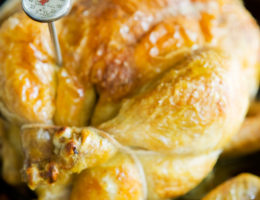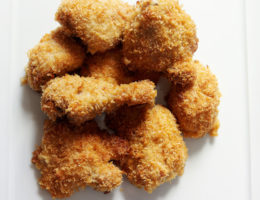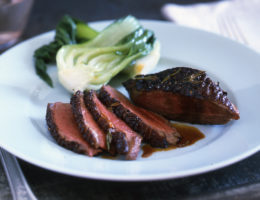I’m not going to give a recipe for coq au vin since I think we’ll become better cooks without one. More valuable is a description of the principles at play and an analysis of how the preparation works.
Traditionally, a rooster for a coq au vin should be marinated with aromatic vegetables and a bouquet garni in red wine. The aromatic vegetables and the wine are then used to braise the rooster, about 3 hours. The braising liquid is finished with beurre manié and the rooster’s blood. The braising liquid needs to be whisked into the blood and not the other way around or the blood will curdle. The cooked aromatic elements (onions, carrots, bouquet garni etc.) are removed and discarded (although some clever cooks puree them—not the bouquet garni–and use them to bind the sauce) and a separate “garniture” of glazed pearl onions, sautéed mushrooms, and little lardons of bacon is stirred into the stew just before serving.
If you have a real mature rooster, this is pretty straightforward, but most of the time we encounter or prepare “coq au vin”, we’re using a banal chicken, inappropriate for long braising. In the interests of authenticity, such a dish should be called “poulet au vin rouge.”
One might be tempted to assume that an identical process, with the braising time shortened, can be used to braise a chicken rather than a rooster. But there are problems. Since a cut-up chicken will cook in about 20 minutes in simmering red wine, the red wine and aromatic ingredients have no time to cook and the wine’s tannins and acids may remain harsh. The dish may have a raw wine taste. When using red wine, first, select a wine that is soft, that doesn’t have too much acidity or tannin, that’s a bit oaky, and very full-bodied. (Traits I like in cooking are often the opposite of those I like in drinking.) I find wines from Argentina to be particularly good cooking wines.
Once the wine in hand, the obvious solution is to simmer the wine ahead of time, before using it to cook the chicken. But wine simmered alone just becomes harsh and aggressive. Red wine must be cooked with proteins so the proteins clarify out the tannins and soften the acidity. So the trick is this: make a red wine stock in the same way you make stock with water (substitute the wine for the water) by first browning drum sticks or wings (dark meat is best; just buy the cheapest) and aromatic vegetables and then simmering them for 3 hours or so in the red wine. The resulting “stock” can then be degreased and reduced and used to cook our chicken.
Brown the cut-up chicken in butter (or lard if you have it—don’t use bacon fat which is too aggressive) until it’s well browned on each side. Take out the chicken. If you’re adding more aromatic vegetables (which may not be necessary since they were included in the red wine stock), cook them in the same pan over medium heat for about 10 minutes to soften them. Take out the vegetables, discard any fat and put the chicken back in. Pour over the wine stock, cover the pan, and simmer about 20 minutes until the chicken feels firm to the touch. (Removing the bone from the thigh ensures that the cooking time for the thighs and breasts is the same.) Take the chicken out, keep it warm, and decide what to do with the braising liquid. There are a couple of approaches. It’s unlikely you’re going to have blood so we’ll skip that for now. But beurre manié is a good option. There is also the possibility of reducing and degreasing the braising liquid until there’s a very small amount left (a half cup or so) and then finishing it with cold cubes of butter—usually about 6 tablespoons. This latter approach makes the dish richer and more intensely flavored but there’s less sauce to go around—but you’ll want less since it’s so rich.
You must also give thought to the garniture. If you’re using the classic garniture, most of the work can be done ahead—just sautéing the mushrooms has to be done at the last minute—including rendering the lardons and glazing the pearl onions.
Fortunately, coq au vin or poulet au vin rouge lend themselves to all sorts of improvisation. First, you can concentrate on a specific wine. While it’s unlikely that the character of a particular wine won’t be obscured by cooking, it’s worth experimenting with specific wines such as Beaujolais, Rhone wines, or red wines from the Loire Valley. Be sure to advertise that you’re using something other than a banal everyday wine by calling your dish coq au beaujolais or poulet au chinon. This takes your dish out of the ordinary and lends it panache. (Although I assure you that there will be nothing ordinary about a poulet au vin rouge made with good red wine stock.)
While the pearl onion/lardon/mushroom combination is delicious and classic (in addition, heart-shaped croutons, tips dipped in chopped parsley are sometimes used to decorate the finished platter) some substitutions are obvious. Using wild mushrooms will elevate your dish to celestial realms. A bit of chopped truffle would do no harm either. Also, add a spot of Cognac (not “brandy”) to your sauce about a minute before serving (be sure to cook off the alcohol). On the other end of the spectrum, you may want to simplify your dish by including the carrots, celery, and onions that were used for the braising. This, in fact, is the difference between cuisine bonne femme, cuisine bourgeoise, and cuisine classique. In cuisine bonne femme, the aromatic garniture (usually carrots, onion and celery) is left in the dish and becomes the final garniture (keep in mind that the vegetables can also be pureed and used to thicken the sauce). In cuisine bourgeoise, aromatic vegetables are added to the stew at an appropriate time during the cooking; in cuisine classique, the garniture is prepared completely separately (as for a classic coq au vin).



Very valuable post, thank you. I believe improvisation is at the base of good cooking, but improvisation is only successful when you understand the principles at play. Your discussion of the elements of coq au vin will help any cook approach the dish, armed with the necessary to make it their own.
Thank you. I’m glad you think that the coq au vin piece gives people enough of a sense of what’s going on that they can use the information to prepare other dishes as well. At least the red wine cooking information is pretty universal.
Finally, someone called out the need to change the cooking process and timing for this classic recipe to reflect todays chicken. I’ve been saying this for years to anyone who will listen! Thanks for verifying what my gut told me already.
Thank you.
Hello, Chef
My question is, can you marinate the chicken in the red wine, overnight, and then make the red wine stock? If no, then can you make the red wine stock independently and marinate the chicken in red wine which won’t be used to make the red wine stock?
Thank you,
–Bradd